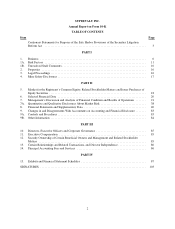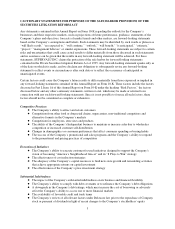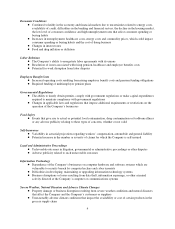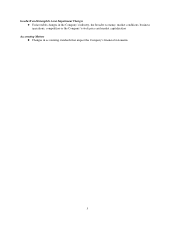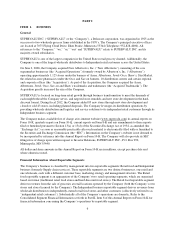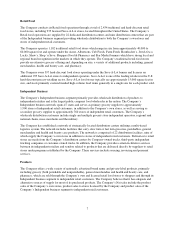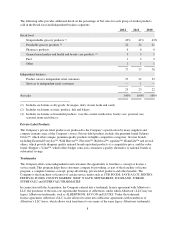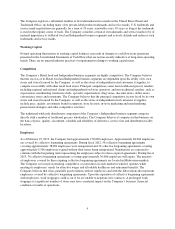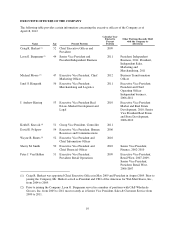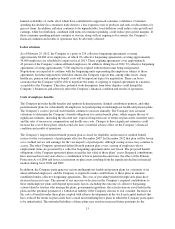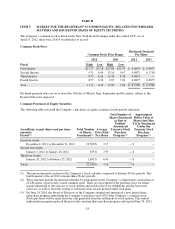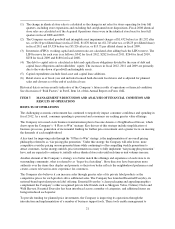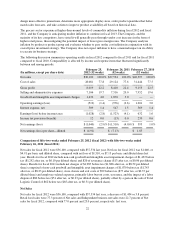Albertsons 2012 Annual Report Download - page 16
Download and view the complete annual report
Please find page 16 of the 2012 Albertsons annual report below. You can navigate through the pages in the report by either clicking on the pages listed below, or by using the keyword search tool below to find specific information within the annual report.Plays to Win” strategy’s business initiatives include providing simplified business processes, funding for price
investment and liquidity, greater customer value offerings, fresher products, including produce, business
flexibility to meet the demands of their neighborhood and a hassle free customer experience, expanding the
Company’s presence, and aligning the Company with its independent retail customers. The Company plans to
roll out price investments across its banners, increase the number of hard-discount stores and to reinvest in its
existing retail store base through remodels and merchandising initiatives tailored to the unique needs of each
particular store’s neighborhood. If the Company is unable to execute on these initiatives, the Company’s
financial condition and results of operations may be adversely affected.
Substantial indebtedness
The Company has, and expects to continue to have, a substantial amount of debt. The Company’s substantial
indebtedness may increase the Company’s borrowing costs and decrease the Company’s business flexibility,
making it more vulnerable to adverse economic conditions. For example, high levels of debt could:
• require the Company to use a substantial portion of its cash flow from operations for the payment of
principal and interest on its indebtedness, thereby reducing the availability of cash flow to fund
working capital, capital expenditures, acquisitions, and other purposes;
• limit the Company’s ability to obtain, or increase the cost at which the Company is able to obtain
financing in order to refinance existing indebtedness and fund working capital, capital expenditures,
acquisitions and other purposes;
• limit the Company’s ability to adjust to changing business and market conditions placing the Company
at a competitive disadvantage relative to its competitors that have less debt; and
• in combination with recent reductions to the book value of the Company’s stockholders’ equity on the
Company’s balance sheet and its associated surplus under Delaware law, require consideration of
additional factors prior to repurchasing stock or paying dividends.
There are various financial covenants and other restrictions in the Company’s debt instruments. If the Company
fails to comply with any of these requirements, the related indebtedness (and other unrelated indebtedness) could
become due and payable prior to its stated maturity and the Company may not be able to repay the indebtedness
that becomes due. A default under the Company’s debt instruments may also significantly affect the Company’s
ability to obtain additional or alternative financing.
The Company’s ability to comply with the covenants or to refinance the Company’s obligations with respect to
the Company’s indebtedness will depend on the Company’s operating and financial performance, which in turn
is subject to prevailing economic conditions and to financial, business and other factors beyond the Company’s
control. In particular, the uncertainties of the global economy and capital markets may impact the Company’s
ability to obtain debt financing. These conditions and factors may also negatively impact the Company’s debt
ratings, which may increase the cost of borrowing, adversely affect the Company’s ability to access one or more
financial markets or result in a default under the Company’s debt instruments.
Any of these outcomes may adversely affect the Company’s financial condition and results of operations.
Current economic conditions
All of the Company’s store locations are located in the United States making its results highly dependent on U.S.
consumer confidence and spending habits. The U.S. economy has experienced economic volatility in recent years
due to uncertainties related to higher unemployment rates, energy costs, a decline in the housing market, and
12


